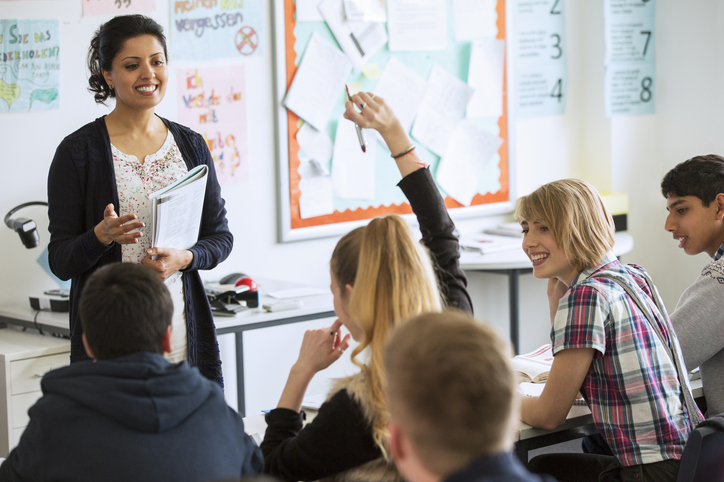
Karen Martin
Director of learning and instruction for Denali Borough School District in Healy, Alaska
Karen Martin is the director of learning and instruction for Denali Borough School District in Healy, Alaska. Before, she was the district’s instructional coach and an elementary teacher. She was a Fulbright Distinguished Awards in Teaching grantee to Finland in 2014, a Fund for Teachers Fellow to Finland in 2017, and a finalist for Alaska Teacher of the Year in 2018. She has lived and taught in Alaska for 17 years, where she has headed a teacher-led, grassroots effort to create a network of rural teachers. She is also currently a graduate student researching teacher agency at the University of Alaska Fairbanks.
During my life as an educator, there are only a few times when I’ve seen teachers engage in professional learning or collaboration that resulted in understanding the direct impact they had on student learning and how much control they had over those learning experiences.
Mark and Paula are co-teachers in our middle school. Between them, they’re responsible for the learning in all content areas for our 40 or so middle school students. In spring 2021, they and five of their Denali Borough School District colleagues participated in a Teacher as Researcher project with Marzano Research. As part of this work, they engaged in instructional improvement cycles, a process to help teachers use data from their classroom assessments to evaluate promising practices.
Throughout this project, I witnessed teachers empowered by having the space to inquire into their own practice, analyze evidence of student learning, repeat and refine their instructional design based on evidence, and see their impact. My colleagues had time to focus on innovating their instruction and examining direct evidence of their actions on student learning. This is the kind of professional learning that leads to greater teacher agency and raises our profession.
Mark’s Experience
Mark values students’ conversation as they work together to build mathematical knowledge. He gathered research articles that described communication strategies in math instruction. From this research, he decided to innovate a type of collaborative assessment as an instructional strategy to increase positive peer pressure and raise levels of student engagement and performance.
Through this strategy, one student from a small group of students was randomly chosen to share the group’s solution to a math problem. If the student couldn’t explain the solution correctly or if the group’s solution was wrong, Mark would tell the group they needed to fix their error and would come back to talk with the same student. He saw the pressure placed on the group positively impact their collaborative work because they had to make sure everyone had a shared understanding of the problem and could explain it. He saw students become more aware of their lack of understanding through the pressure of having to answer and realizing they didn’t have it down. The students showed gains in knowledge of the math concepts they learned on assessments that they took both before and after Mark implemented the instructional strategy.
Paula’s Experience
Paula was discouraged by her social studies students’ inability to articulate their understanding of content-specific learning targets in writing. She wasn’t sure if this was because they were developing writers or if they really didn’t understand the content. She began by analyzing the content and using explicit instruction to teach her students to filter information by taking notes directly aligned to learning targets.
Paula determined this note-taking strategy only had a slight effect on increasing student learning. She realized she needed to do more. She then taught her students strategically how to craft sentences using sentence frames and how to analyze weaker and stronger student writing based on how well learning targets were supported by evidence in the text. In her second instructional improvement cycle, she saw a dramatic impact on her students’ achievement through their ability to articulate their understanding in writing directly related to her intentional instructional design.
Paula’s results were powerful. When looking at her students’ final writing samples, she couldn’t see a difference between their performances. They all created high-quality writing with equal ability. She didn’t realize how much influence her teaching really had until she looked so intentionally between what she was doing and the evidence directly connected to it.
Empowered Teachers with Greater Agency
Mark’s and Paula’s learning experiences as “teacher researchers” were deeply relevant and had immediate impacts on their classroom practice. They chose the focus of their inquiry based on their knowledge of pedagogies. They investigated the instructional strategies they chose and designed assessments directly linked to their learning outcomes. They systematically gathered evidence to determine their impact on student learning.
This type of professional learning leads to empowered teachers with greater agency. It should be the norm and the way we work together as professionals. We have the power to change our beliefs about our collective capacities through the nature of the work and the conversations we engage in. Marzano Research’s Teacher as Researcher approach exemplifies the collaborative work that can raise our profession from within.
Would you like to conduct a Teacher as Researcher project in your district or learn more about how we can help your professional learning community? Contact Trudy Cherasaro at Trudy.Cherasarao@MarzanoResearch.com.



